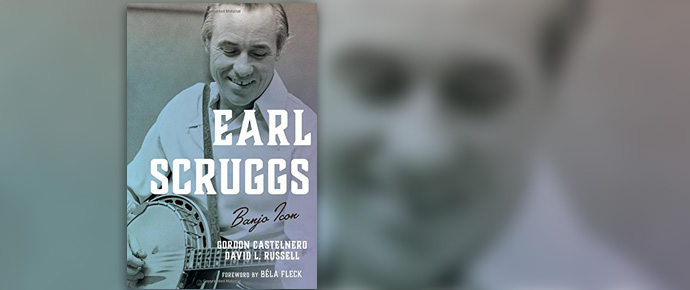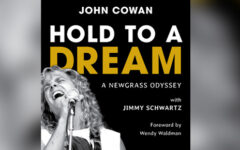
Banjo aficionados and Earl Scruggs devotees, in particular, will be enthused, nay, excited, by the news of a forthcoming book about the banjo innovator, Earl Scruggs: Banjo Icon, published by Rowman & Littlefield Publishers.
Earl Scruggs’s career as a banjo player started at the age of 15 when he played with the Carolina Wildcats, before his first salaried job with Lost John Miller and his Allied Kentuckians in 1945 when he was 21.
Universal recognition of Scruggs and his three-finger style of playing the banjo began late in 1945, when Jim Shumate brought him to play with Bill Monroe’s Blue Grass Boys. He remained with Monroe until early 1948, shortly after which Scruggs teamed up with guitarist Lester Flatt, another member of the famed ‘original’ bluegrass band.
The Lester Flatt – Earl Scruggs combo brought greater awareness of the 5-string banjo with Scruggs’s composition Foggy Mountain Breakdown, the best known of all bluegrass banjo tunes, and their Ballad of Jed Clampett, well-known through the TV series The Beverly Hillbillies.
Even more recognition came when the film Bonnie & Clyde featured Foggy Mountain Breakdown in its soundtrack in 1967.
Following the split from Lester Flatt early in 1969, Scruggs formed the Earl Scruggs Revue with his sons, Randy (playing guitar) and Gary (bass) initially, and later Steve (piano), switching from a ‘traditional’ style of bluegrass to a progressive form of music.
In 1980 back problems forced Scruggs to stop his constant touring schedule and limit his profile to recording work.
Scruggs has multiple awards from throughout his career, including induction (with Lester Flatt) into the Country Music Hall of Fame (in 1985) and in 1991, he was one of the first inductees into the IBMA Hall of Fame along with Lester Flatt and Bill Monroe.
He collaborated with similarly illustrious stars such as Billy Joel, Elton John, Sting, Johnny Cash, Bob Dylan, Joan Baez, Vince Gill, Travis Tritt, the Byrds, and Steve Martin.
In 1989, Scruggs was awarded a National Heritage Fellowship given by the National Endowment for the Arts, the highest honor in the folk and traditional arts in the USA.
On the morning of March 28, 2012, he passed away due to natural causes in a Nashville hospital.
Scruggs’s influence remains universal. Few musicians in any style have had such a lasting impact on an instrument and a musical form as has Scruggs with bluegrass banjo. It is possible to say that without his contribution, neither would have ever existed.
Recently we took the opportunity to talk to authors Gordon Castelnero, a Michigan-based freelance documentary writer/producer and author; and David L. Russell, a writer, musician and banjo teacher, who has toured with a number of bluegrass bands in Michigan and Georgia.
You’re a banjo player yourself; tell me about your early interest in the instrument, please? When did your affiliation with Scruggs’ style banjo begin and what were the circumstances? (Answered by David Russell)
“My mother’s family hails from the Smoky Mountain region of East Tennessee, and we traveled there often to visit relatives, and to camp out in the mountains. I had heard the banjo played here and there, but I never really paid much attention until I saw/heard it played live. I first encountered the banjo when I was about five years old on one of our trips south. I remember seeing an old man with a long beard, playing the banjo and shuffling his feet on the streets of Gatlinburg, Tennessee. He may have been playing clawhammer style banjo, I’m not certain, yet I still recall being attracted to that sound. Not long after those first encounters with the banjo, I became aware of Earl Scruggs’s machinegun-like playing on The Beverly Hillbillies. I noticed a vast difference between the sound of that old man’s banjo and the near perfect sound of Earl’s banjo on The Ballad of Jed Clampett. In the summer of 1975, my dad and I decided to catch the Smoky Mountain Travelers bluegrass show at a motel in Gatlinburg, and that is when I decided to become a banjo player. The guy playing banjo in the band was a local Knoxville, Tennessee-player named Bill Chambers. After a particularly great banjo solo I turned to my dad and told him that I wanted to be a banjo player, but I don’t think he took me seriously.
That summer I bought my first banjo; a cheap, aluminum pot noise maker I later referred to as a canoe paddle. I took a few months’ worth of lessons from a guy named Bill Ryan, and he was pretty good in light of the fact that he was mainly a guitar player. He taught me from the Earl Scruggs banjo instruction book. I progressed to the point where he told me that I needed to hang out with more advanced banjo players, and that he had taught me as much as he could teach. Soon I befriend local Detroit bluegrass banjoists like Mitch Manns, Dana Cupp Jr., and Tim Ellis. These guys were hardcore Scruggs aficionados, and knew that style of banjo very well, especially Dana Cupp, and Mitch Manns. I eventually added melodic style banjo to my arsenal of banjo knowledge, yet I never strayed too far from Scruggs style. Earl has always been the standard for anything I attempted to do on the banjo. I wore out three copies of Foggy Mountain Banjo, and just about every other Flatt & Scruggs album I possessed. I was also a huge student of J. D. Crowe, and Sonny Osborne; I still am a huge fan.”
How did that interest develop into the idea for a book? (Answered by David Russell)
“It would be many years before the thought of actually writing a book on Earl would manifest itself in my mind. I have always loved writing and research, but I didn’t give a Scruggs book serious thought until I was writing my Ph.D. dissertation in the early 1990s. I decided that I would make it a bucket list goal to write a book on Earl Scruggs. It wasn’t until July of 2014 that I made contact with a former banjo student of mine in the 1970s (Gordon Castelnero) and made plans to meet him at a Detroit-area, Coney-Island restaurant to discuss my idea for writing a book on Earl. I asked him if he wanted to be a part of the project, but at that time he was not interested; however, he would be willing to assist me. By late fall, Gordon changed his mind and wanted to be a part of the project. We re-connected around Thanksgiving and set a date to meet in early December to hash out a formal outline and proposal for the book. Our research and interview process began after the Christmas holidays in January 2015. We began serious writing in May 2015. Gordon, by the way, was one of my best banjo students in the late 1970s. Little did we think that one day we would write the first ever book about Earl Scruggs. He has a degree in Radio/Television/Film from California State University (Long Beach), while my background is in the academic world of philosophy and history; in addition to a background as a Scruggs-style banjo teacher and touring musician. Our backgrounds have proven to be very complimentary in this journey together.”
In the book – it’s a biography, isn’t it – do you and your co-writer, Gordon Castelnero, each focus on different aspects of Scruggs life and banjo playing or is it a seamless telling of Earl Scruggs life as a man, a husband, a father and a banjo player etc? (Answered by Gordon Castelnero)
“The book is an oral history of the life and legacy of Earl Scruggs. Our first outline was hashed out in a restaurant over a breakfast meeting in early December 2014. We wanted to showcase everything about Earl in terms of his biography, style of playing, signature songs, media presence, and his disciples. We divided up the topics: David (being the professional banjoist) worked on Scruggs style, signature songs, and Earl’s disciples, while I tackled the biography and media appearances.
About a month or two into our work, we realized that the original table of contents needed to be overhauled, as the research and interviews were taking us in directions beyond our initial concept. We revised the contents into two sections: the first would be Earl’s life, and the second would be his legacy. David stuck with the technical and influential components of Scruggs as a musician. He later incorporated the various Gibson models from Earl’s banjo arsenal. Meanwhile, I continued with Scruggs’s biography which was rapidly expanding and becoming more complex.
When it came time to put the chapters together, our ‘half-n-half’ approach didn’t seem to look right or read well. It was evident that we would need to blend our chapters together so they tell a more linear story about Earl Scruggs as a man and musician. The introduction provides an in-depth study of Earl’s skill set (roll patterns, timing, tone, and drive) to better identify, up front, what made him so iconic. The next seven chapters tell the story of the amazing life and times of Scruggs from his humble beginnings on a farm in rural North Carolina to becoming a musical legend who inspired countless musicians worldwide. The eighth (and final) chapter is an extensive testimonial depicting the multi-generational impact Scruggs had on music’s biggest and brightest five-string banjo players.
We conducted 71 interviews comprised of numerous musicians in bluegrass and country music, several entertainment professionals, and the Scruggs family. The end result is an easy to read narrative that’s filled with personal stories from the collective memories of those who knew, admired and loved Earl Scruggs.”
Earl Scruggs: Banjo Icon will be available later this month (March 2017), published by Rowman & Littlefield Publishers.
256 pages, Size 6 x 9 inches
Hardback edition: 978-1-4422-6865-4, March 16, 2017, $40.00
eBook version: 978-1-4422-6866-1, March 2017, $39.99
However, the book is now available for pre-order from the publishers with a 30% discount using Code ref: 7A30AUTHF.
Look out for information about what is expected to be a busy book signing, public speaking, and lecture schedule that is still being finalized.







